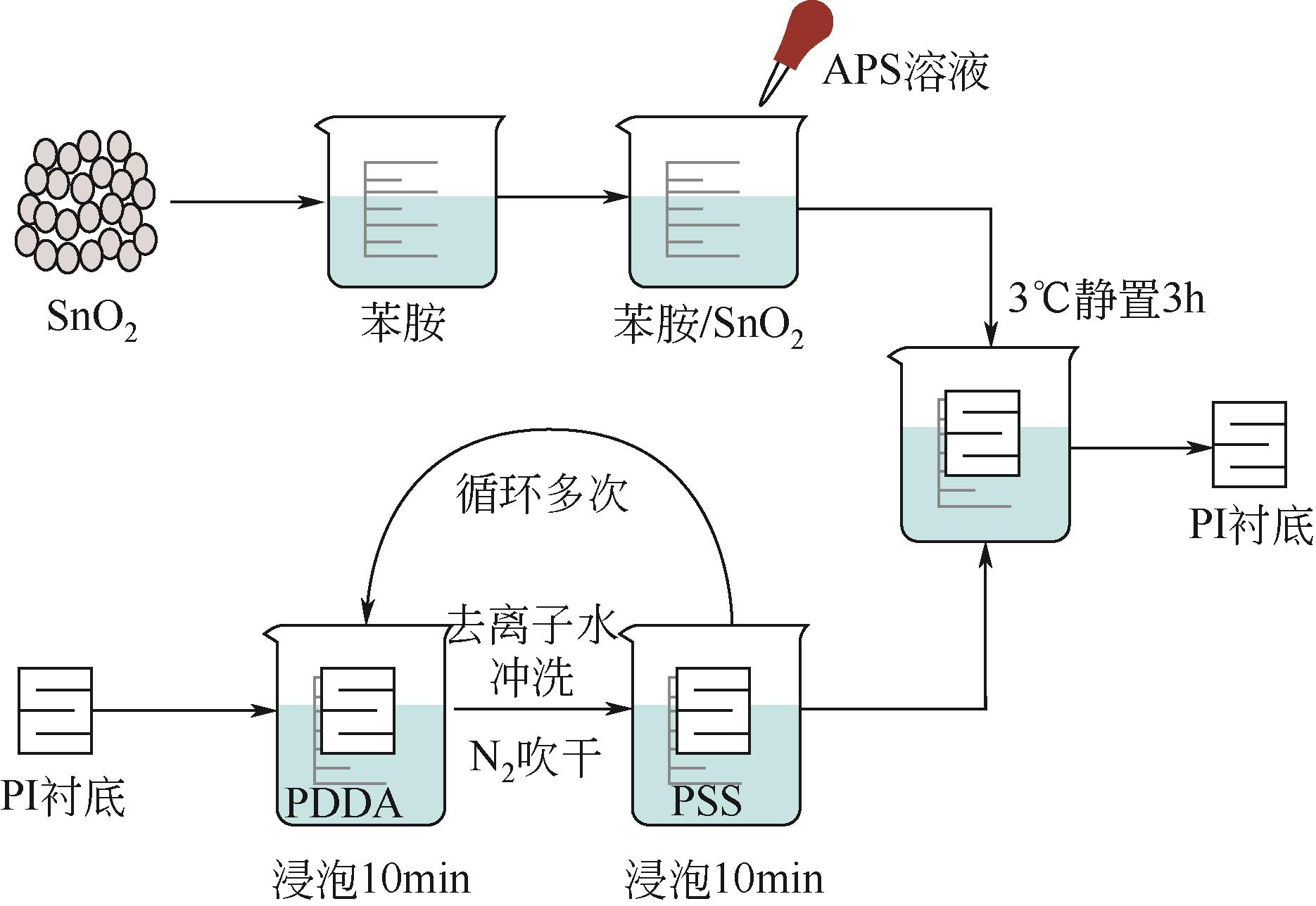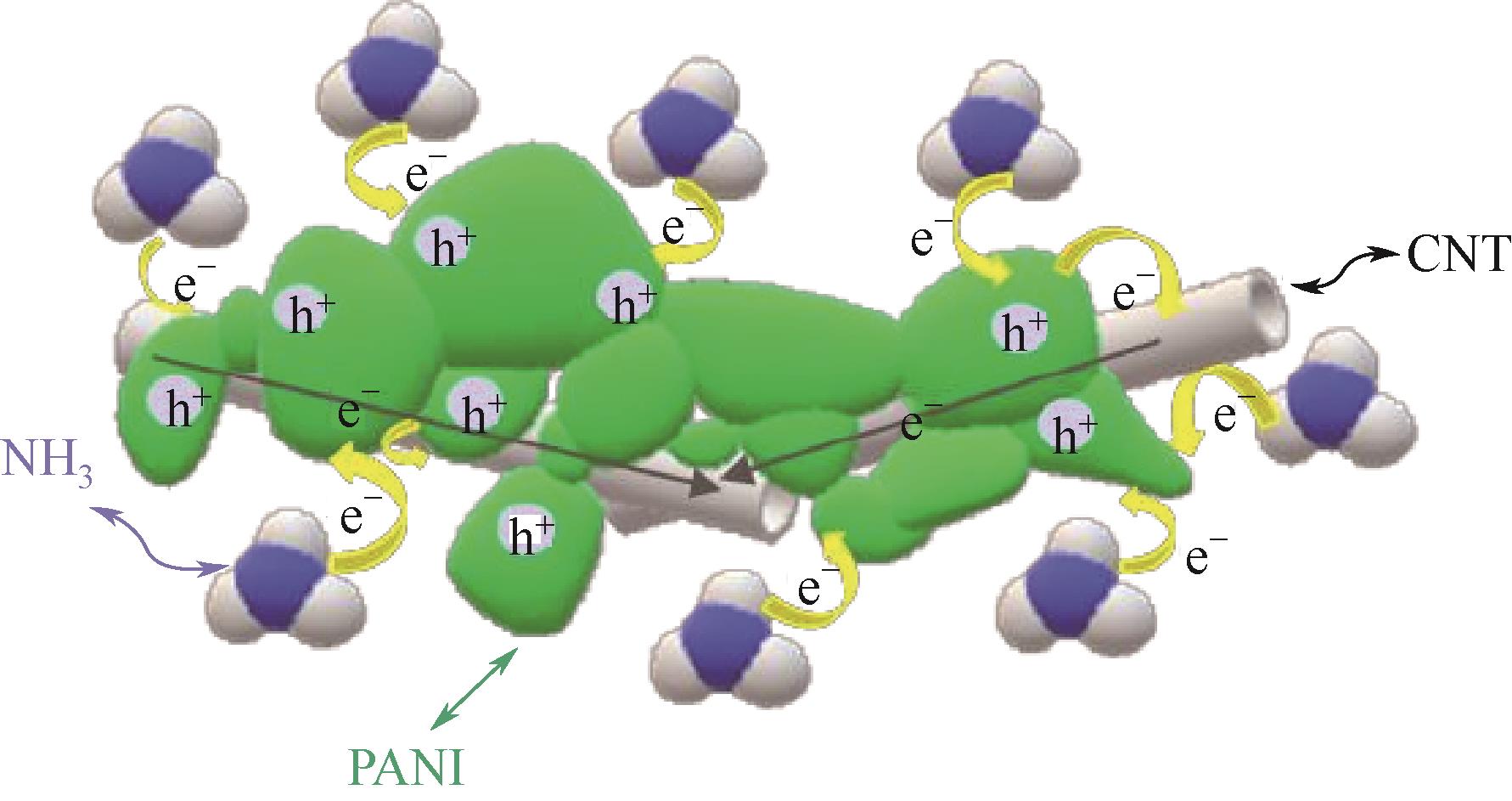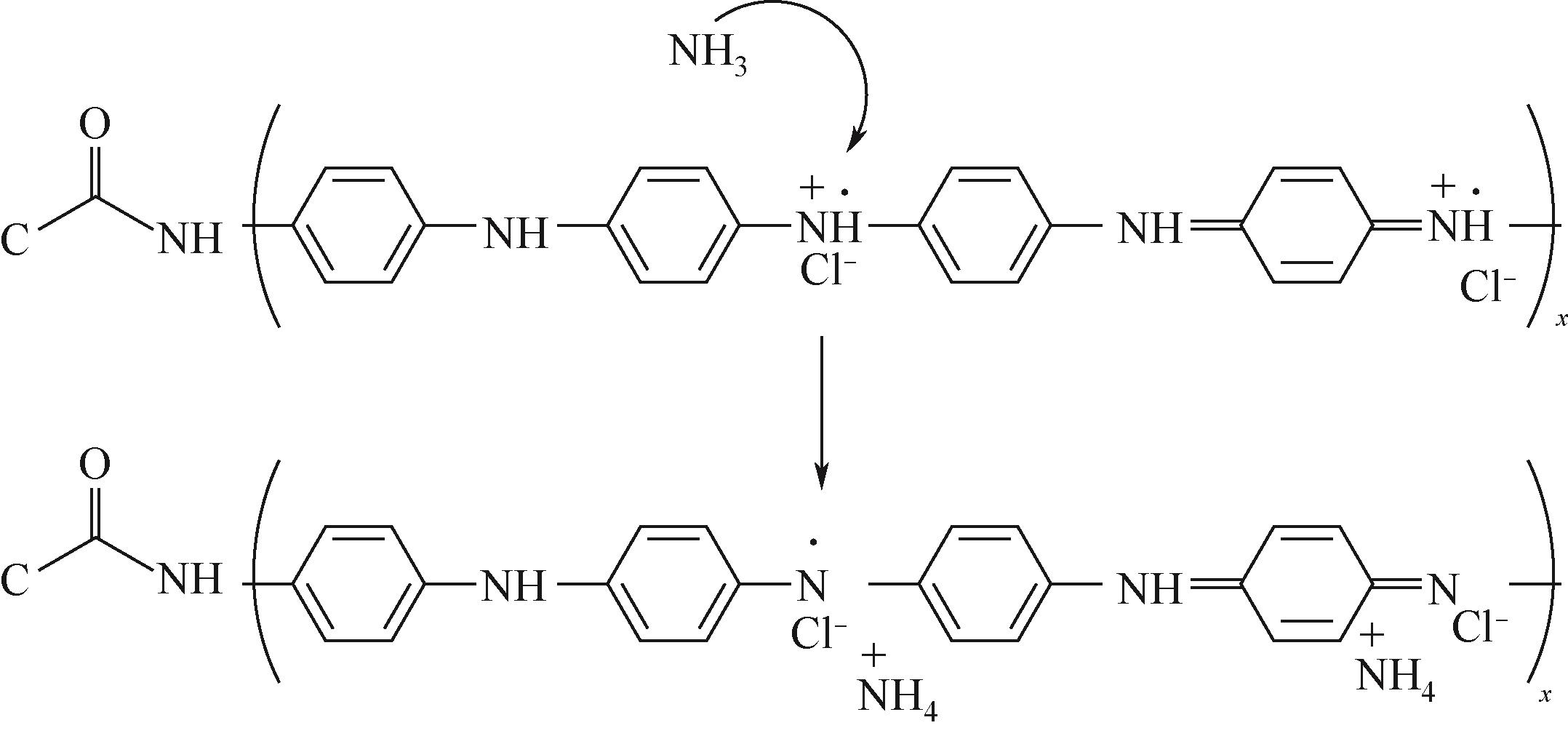Chemical Industry and Engineering Progress ›› 2023, Vol. 42 ›› Issue (3): 1448-1456.DOI: 10.16085/j.issn.1000-6613.2022-0787
• Materials science and technology • Previous Articles Next Articles
Research progress of polyaniline/carbon nanotube gas sensing materials
XUE Bo( ), YANG Tingting(
), YANG Tingting( ), WANG Xuefeng
), WANG Xuefeng
- School of Safety and Emergency Management Engineering, Taiyuan University of Technology, Taiyuan 030024, Shanxi, China
-
Received:2022-04-29Revised:2022-05-27Online:2023-04-10Published:2023-03-15 -
Contact:YANG Tingting
聚苯胺/碳纳米管气敏材料的研究进展
- 太原理工大学安全与应急管理工程学院,山西 太原 030024
-
通讯作者:杨婷婷 -
作者简介:薛博(1995—),男,硕士研究生,研究方向为灾害防治理论与技术。E-mail:bogege0530@163.com。 -
基金资助:山西省应用基础研究计划(20210302124484)
CLC Number:
Cite this article
XUE Bo, YANG Tingting, WANG Xuefeng. Research progress of polyaniline/carbon nanotube gas sensing materials[J]. Chemical Industry and Engineering Progress, 2023, 42(3): 1448-1456.
薛博, 杨婷婷, 王雪峰. 聚苯胺/碳纳米管气敏材料的研究进展[J]. 化工进展, 2023, 42(3): 1448-1456.
share this article
Add to citation manager EndNote|Ris|BibTeX
URL: https://hgjz.cip.com.cn/EN/10.16085/j.issn.1000-6613.2022-0787
| 1 | 宋晓岚, 闫程印, 张颖, 等. 气敏材料的研究进展及展望[J]. 材料导报, 2012, 26(11): 36-39, 44. |
| SONG Xiaolan, YAN Chengyin, ZHANG Ying, et al. Research progress and prospect of gas sensitive materials[J]. Materials Review, 2012, 26(11): 36-39, 44. | |
| 2 | 周媛媛, 余旻, 李松, 等. 导电高分子材料聚苯胺的研究进展[J]. 化学推进剂与高分子材料, 2007, 5(6): 14-19. |
| ZHOU Yuanyuan, YU Min, LI Song, et al. Research progress of the conductive polymer material—Polyaniline[J]. Chemical Propellants & Polymeric Materials, 2007, 5(6): 14-19. | |
| 3 | 曹友桂, 章于川, 郑广鹏. 导电聚苯胺复合材料的研究进展[J]. 广东化工, 2012, 39(2): 84, 56. |
| CAO Yougui, ZHANG Yuchuan, ZHENG Guangpeng. The research progress on conductive polymer of polyaniline composites[J]. Guangdong Chemical Industry, 2012, 39(2): 84, 56. | |
| 4 | 包建文. 碳纳米管增强聚合物基复合材料进展[J]. 中国材料进展, 2009, 28(6): 19-27. |
| BAO Jianwen. Advance in polymer matrix nanocomposite reinforced by carbon nanotubes[J]. Materials China, 2009, 28(6): 19-27. | |
| 5 | 李丹丹. 聚苯胺/碳纳米管复合材料的制备及性能研究[D]. 天津: 河北工业大学, 2010. |
| LI Dandan. Study on preparation and performance of polyaniline/carbon nanotube composites[D]. Tianjin: Hebei University of Technology, 2010. | |
| 6 | 章家立, 甘维. 聚苯胺/碳纳米管复合材料的研究进展[J]. 中国塑料, 2013, 27(10): 1-5. |
| ZHANG Jiali, GAN Wei. Research progress of polyaniline/carbon nanotube composites[J]. China Plastics, 2013, 27(10): 1-5. | |
| 7 | HIRATA M, SUN L Y. Characteristics of an organic semiconductor polyaniline film as a sensor for NH3 gas[J]. Sensors and Actuators A: Physical, 1994, 40(2): 159-163. |
| 8 | 谢英男, 詹自力, 张红芹, 等. 十二烷基苯磺酸掺杂聚苯胺的气敏性能研究[J]. 电子元件与材料, 2008, 27(3): 5-8. |
| XIE Yingnan, ZHAN Zili, ZHANG Hongqin, et al. Study on gas-sensing properties of dodecylbenzenesulfonic acid doped polyaniline[J]. Electronic Components and Materials, 2008, 27(3): 5-8. | |
| 9 | HUANG J X, KANER R B. Nanofiber formation in the chemical polymerization of aniline: a mechanistic study[J]. Angewandte Chemie International Edition, 2004, 43(43): 5817-5821. |
| 10 | RIZZO G, ARENA A, DONATO N, et al. Flexible, all-organic ammonia sensor based on dodecylbenzene sulfonic acid-doped polyaniline films[J]. Thin Solid Films, 2010, 518(23): 7133-7137. |
| 11 | HUANG J X, VIRJI S, WEILLER B H, et al. Polyaniline nanofibers: facile synthesis and chemical sensors[J]. Journal of the American Chemical Society, 2003, 125(2): 314-315. |
| 12 | VIRJI S, HUANG J X, KANER R B, et al. Polyaniline nanofiber gas sensors: examination of response mechanisms[J]. Nano Letters, 2004, 4(3): 491-496. |
| 13 | 孙凡. 电纺聚苯胺纳米纤维传感器的制备及其气敏性研究[D]. 杭州: 浙江大学, 2015. |
| SUN Fan. Preparation and study on gas sensing of PANI nanofiber sensor based on electrospinning[D]. Hangzhou: Zhejiang University, 2015. | |
| 14 | 徐子谦. 无机化学前沿综述[J]. 当代化工研究, 2017(4): 13-15. |
| XU Ziqian. Frontier review of inorganic chemistry[J]. Modern Chemical Research, 2017(4): 13-15. | |
| 15 | TAI Huiling, JIANG Yadong, XIE Guangzhong, et al. Fabrication and gas sensitivity of polyaniline-titanium dioxide nanocomposite thin film[J]. Sensors and Actuators B: Chemical, 2007, 125(2): 644-650. |
| 16 | ABACI S, NESSARK B, RIAHI F. Preparation and characterization of polyaniline+TiO2 composite films[J]. Ionics, 2014, 20(12): 1693-1702. |
| 17 | RAM M K, YAVUZ Ö, LAHSANGAH V, et al. CO gas sensing from ultrathin nano-composite conducting polymer film[J]. Sensors and Actuators B: Chemical, 2005, 106(2): 750-757. |
| 18 | 朱涛, 常燕, 段力峰, 等. 聚苯胺-TiO2复合膜的气敏性能研究[J]. 材料开发与应用, 2020, 35(4): 1-5. |
| ZHU Tao, CHANG Yan, DUAN Lifeng, et al. Research on gas sensing properties of PANI-TiO2 composite film[J]. Development and Application of Materials, 2020, 35(4): 1-5. | |
| 19 | 崔艳雷, 张铭, 李雪伟, 等. 柔性PANI-SnO2复合薄膜的制备及其对NH3的气敏特性[J]. 微纳电子技术, 2019, 56(7): 570-574, 592. |
| CUI Yanlei, ZHANG Ming, LI Xuewei, et al. Preparation and NH3 gas sensing properties of PANI-SnO2 flexible composite film[J]. Micronanoelectronic Technology, 2019, 56(7): 570-574, 592. | |
| 20 | 戚暨. 苯胺原位聚合法制备气敏织物及其气体传感性能研究[D]. 沈阳: 东北大学, 2013. |
| QI Ji. Preparation of gas sensitive fabrics through in situ polymerization of aniline and its gas sensing property[D]. Shenyang: Northeastern University, 2013. | |
| 21 | LI Z F, BLUM F D, BERTINO M F, et al. One-step fabrication of a polyaniline nanofiber vapor sensor[J]. Sensors and Actuators B: Chemical, 2008, 134(1): 31-35. |
| 22 | ATHAWALE A A, BHAGWAT S V, KATRE P P. Nanocomposite of Pd-polyaniline as a selective methanol sensor[J]. Sensors and Actuators B: Chemical, 2006, 114(1): 263-267. |
| 23 | WU Zuquan, CHEN Xiangdong, ZHU Shibu, et al. Enhanced sensitivity of ammonia sensor using graphene/polyaniline nanocomposite[J]. Sensors and Actuators B: Chemical, 2013, 178: 485-493. |
| 24 | 田俊峰, 陈哲, 韩光鲁, 等. 三维石墨烯/聚苯胺纳米线复合材料合成及室温气敏性能[J]. 化工新型材料, 2019, 47(3): 51-54. |
| TIAN Junfeng, CHEN Zhe, HAN Guanglu, et al. Preparation of 3D-rGO/PANI nanofiber and its H2 sensitivity at room temperature[J]. New Chemical Materials, 2019, 47(3): 51-54. | |
| 25 | ZHANG T, MUBEEN S, MYUNG N V, et al. Recent progress in carbon nanotube-based gas sensors[J]. Nanotechnology, 2008, 19(33): 332001. |
| 26 | BONDAVALLI P, LEGAGNEUX P, PRIBAT D. Carbon nanotubes based transistors as gas sensors: state of the art and critical review[J]. Sensors and Actuators B: Chemical, 2009, 140(1): 304-318. |
| 27 | KANIYOOR A, IMRAN JAFRI R, AROCKIADOSS T, et al. Nanostructured Pt decorated graphene and multi walled carbon nanotube based room temperature hydrogen gas sensor[J]. Nanoscale, 2009, 1(3): 382-386. |
| 28 | ASAD M, SHEIKHI M H. Surface acoustic wave based H2S gas sensors incorporating sensitive layers of single wall carbon nanotubes decorated with Cu nanoparticles[J]. Sensors and Actuators B: Chemical, 2014, 198: 134-141. |
| 29 | KONG Jing, FRANKLIN N R, ZHOU Chongwu, et al. Nanotube molecular wires as chemical sensors[J]. Science, 2000, 287(5453): 622-625. |
| 30 | GOLDONI A, LARCIPRETE R, PETACCIA L, et al. Single-wall carbon nanotube interaction with gases: sample contaminants and environmental monitoring[J]. Journal of the American Chemical Society, 2003, 125(37): 11329-11333. |
| 31 | PENG Shu, CHO Kyeongjae. Ab initio study of doped carbon nanotube sensors[J]. Nano Letters, 2003, 3(4): 513-517. |
| 32 | 杨俊卿, 魏忠, 李鸿波. 功能化单壁碳纳米管的气敏性研究[J]. 武汉理工大学学报, 2012, 34(4): 5-7. |
| YANG Junqing, WEI Zhong, LI Hongbo. Sensing behavior of functionalized single-walled carbon nanotubes[J]. Journal of Wuhan University of Technology, 2012, 34(4): 5-7. | |
| 33 | ESPINOSA E H, IONESCU R, BITTENCOURT C, et al. Metal-decorated multi-wall carbon nanotubes for low temperature gas sensing[J]. Thin Solid Films, 2007, 515(23): 8322-8327. |
| 34 | KUMAR M K, RAMAPRABHU S. Palladium dispersed multiwalled carbon nanotube based hydrogen sensor for fuel cell applications[J]. International Journal of Hydrogen Energy, 2007, 32(13): 2518-2526. |
| 35 | KAUR BILLING B, AGNIHOTRI P K, SINGH N. Fabrication of branched nanostructures for CNT@Ag nano-hybrids: application in CO2 gas detection[J]. Journal of Materials Chemistry C, 2017, 5(17): 4226-4235. |
| 36 | 史克英, 陈垒, 李丽, 等. MWCNTs/SnO2复合材料的制备及室温NO气敏性研究[J]. 黑龙江大学自然科学学报, 2011, 28(4): 490-497. |
| SHI Keying, CHEN Lei, LI Li, et al. Preparation of multi-walled carbon nanotubes-SnO2 composite and its gas sensor properties for NO detection at room temperature[J]. Journal of Natural Science of Heilongjiang University, 2011, 28(4): 490-497. | |
| 37 | 陕皓, 张晓波, 刘丽, 等. 掺多壁碳纳米管的ZnO对乙醇的气敏性能[J]. 功能材料, 2012, 43(24): 3460-3462. |
| SHAN Hao, ZHANG Xiaobo, LIU Li, et al. Ethanol sensing properties of multiwalled carbon nanotube-doped ZnO[J]. Journal of Functional Materials, 2012, 43(24): 3460-3462. | |
| 38 | WONGCHOOSUK C, WISITSORAAT A, PHOKHARATKUL D, et al. Multi-walled carbon nanotube-doped tungsten oxide thin films for hydrogen gas sensing[J]. Sensors, 2010, 10(8): 7705-7715. |
| 39 | LI W, HOA N D, KIM D. High-performance carbon nanotube hydrogen sensor[J]. Sensors and Actuators B: Chemical, 2010, 149(1): 184-188. |
| 40 | LIU Bohao, LIU Xueyan, YUAN Zhen, et al. A flexible NO2 gas sensor based on polypyrrole/nitrogen-doped multiwall carbon nanotube operating at room temperature[J]. Sensors and Actuators B: Chemical, 2019, 295: 86-92. |
| 41 | WANG H C, LI Y, YANG M J. Sensors for organic vapor detection based on composites of carbon nonotubes functionalized with polymers[J]. Sensors and Actuators B: Chemical, 2007, 124(2): 360-367. |
| 42 | 梁嘉敏. 导电高分子聚苯胺及其复合材料的制备和气敏性研究[D]. 沈阳: 东北大学, 2020. |
| LIANG Jiamin. Preparation and gas sensitivity of conductive polymer polyaniline and its composites[D]. Shenyang: Northeastern University, 2020. | |
| 43 | 张广迪. 一氧化碳传感器的制备及特性研究[D]. 成都: 电子科技大学, 2014. |
| ZHANG Guangdi. The fabrication of carbon monoxide sensor and study on its performance[D]. Chengdu: University of Electronic Science and Technology of China, 2014. | |
| 44 | 樊桂君. 氧化钨纳米片、碳纳米管改性聚苯胺复合材料的室温氨敏性能研究[D]. 郑州: 郑州大学, 2020. |
| FAN Guijun. Room-temperature ammonia-sensing properties of the polyaniline-based nanocomposites modified with WO3 nanoplates and carbon nanotubes[D]. Zhengzhou: Zhengzhou University, 2020. | |
| 45 | 杨英花. PANI-MWCNTs纳米复合室温柔性氨气传感器的研究[D]. 大连: 大连理工大学, 2018. |
| YANG Yinghua. Study on PANI-MWCNTs nanocomposite room temperature flexible ammonia gas sensor[D]. Dalian: Dalian University of Technology, 2018. | |
| 46 | 杜海英, 王兢, 张秀峰, 等. MWCNTs掺杂的PANI纳米复合材料的制备及敏感特性的研究[J]. 功能材料, 2013, 44(20): 3024-3029. |
| DU Haiying, WANG Jing, ZHANG Xiufeng, et al. Preparation, characterization and gas sensitivity studies of MWCNTs-doped PANI nanocomposites[J]. Journal of Functional Materials, 2013, 44(20): 3024-3029. | |
| 47 | 阚侃, 刘颖, 石雨, 等. Pt负载PANI/CNTs复合纳米线的制备及室温NH3气敏性能研究[J]. 黑龙江科学, 2016, 7(19): 32-35. |
| KAN Kan, LIU Ying, SHI Yu, et al. Preparation of Pt doped PANI/CNTs composite nanowires for NH3 gas sensor at room temperature[J]. Heilongjiang Science, 2016, 7(19): 32-35. | |
| 48 | LI Yang, WANG Huicai, CAO Xiehong, et al. A composite of polyelectrolyte-grafted multi-walled carbon nanotubes and in situ polymerized polyaniline for the detection of low concentration triethylamine vapor[J]. Nanotechnology, 2008, 19(1): 015503. |
| 49 | 曾娴. 碳纳米管阵列复合材料的制备及其在气体传感器中的应用[D]. 苏州: 苏州大学, 2017. |
| ZENG Xian. Preparation of carbon nanotube array composite and its application as a gas sensor[D]. Suzhou: Soochow University, 2017. |
| [1] | LIN Xiaopeng, XIAO Youhua, GUAN Yichen, LU Xiaodong, ZONG Wenjie, FU Shenyuan. Recent progress of flexible electrodes for ion polymer-metal composites (IPMC) [J]. Chemical Industry and Engineering Progress, 2023, 42(9): 4770-4782. |
| [2] | QIAN Sitian, PENG Wenjun, ZHANG Xianming. Comparative analysis of forming cyclic oligomers via PET melt polycondensation and cyclodepolymerization [J]. Chemical Industry and Engineering Progress, 2023, 42(9): 4808-4816. |
| [3] | ZHU Chuanqiang, RU Jinbo, SUN Tingting, XIE Xingwang, LI Changming, GAO Shiqiu. Characteristics of selective non-catalytic reduction of NO x with solid polymer denitration agent [J]. Chemical Industry and Engineering Progress, 2023, 42(9): 4939-4946. |
| [4] | YANG Ying, HOU Haojie, HUANG Rui, CUI Yu, WANG Bing, LIU Jian, BAO Weiren, CHANG Liping, WANG Jiancheng, HAN Lina. Coal tar phenol-based carbon nanosphere prepared by Stöber method for adsorption of CO2 [J]. Chemical Industry and Engineering Progress, 2023, 42(9): 5011-5018. |
| [5] | YIN Xinyu, PI Pihui, WEN Xiufang, QIAN Yu. Application of special wettability materials for anti-hydrate-nucleation and anti-hydrate-adhesion in oil and gas pipelines [J]. Chemical Industry and Engineering Progress, 2023, 42(8): 4076-4092. |
| [6] | LI Bogeng, LUO Yingwu, LIU Pingwei. Consideration on research content and method of polymer product engineering [J]. Chemical Industry and Engineering Progress, 2023, 42(8): 3905-3909. |
| [7] | WANG Baoying, WANG Huangying, YAN Junying, WANG Yaoming, XU Tongwen. Research progress of polymer inclusion membrane in metal separation and recovery [J]. Chemical Industry and Engineering Progress, 2023, 42(8): 3990-4004. |
| [8] | CHEN Junjun, FEI Chang’en, DUAN Jintang, GU Xueping, FENG Lianfang, ZHANG Cailiang. Research progress on chemical modification of polyether ether ketone for the high bioactivity [J]. Chemical Industry and Engineering Progress, 2023, 42(8): 4015-4028. |
| [9] | YU Jingwen, SONG Luna, LIU Yanchao, LYU Ruidong, WU Mengmeng, FENG Yu, LI Zhong, MI Jie. An indole-bearing hypercrosslinked polymer In-HCP for iodine adsorption from water [J]. Chemical Industry and Engineering Progress, 2023, 42(7): 3674-3683. |
| [10] | XU Peiyao, CHEN Biaoqi, KANKALA Ranjith Kumar, WANG Shibin, CHEN Aizheng. Research progress of nanomaterials for synergistic ferroptosis anticancer therapy [J]. Chemical Industry and Engineering Progress, 2023, 42(7): 3684-3694. |
| [11] | GONG Pengcheng, YAN Qun, CHEN Jinfu, WEN Junyu, SU Xiaojie. Properties and mechanism of eriochrome black T degradation by carbon nanotube-cobalt ferrite composites activated persulfate [J]. Chemical Industry and Engineering Progress, 2023, 42(7): 3572-3581. |
| [12] | YU Xixi, ZHANG Jinshuai, LEI Wen, LIU Chengguo. Research progress of self-healing photocuring polymeric materials based on dynamic covalent bonds [J]. Chemical Industry and Engineering Progress, 2023, 42(7): 3589-3599. |
| [13] | SUN Zhengnan, LI Hongjing, JING Guolin, ZHANG Funing, YAN Biao, LIU Xiaoyan. Application of EVA and its modified polymer in crude oil pour point depressant field [J]. Chemical Industry and Engineering Progress, 2023, 42(6): 2987-2998. |
| [14] | XU Chunshu, YAO Qingda, LIANG Yongxian, ZHOU Hualong. Effects of graphene oxide/carbon nanotubes on the properties of several typical polymer materials [J]. Chemical Industry and Engineering Progress, 2023, 42(6): 3012-3028. |
| [15] | REN Jianpeng, WU Caiwen, LIU Huijun, WU Wenjuan. Preparation of lignin-polyaniline composites and adsorption of Congo red [J]. Chemical Industry and Engineering Progress, 2023, 42(6): 3087-3096. |
| Viewed | ||||||
|
Full text |
|
|||||
|
Abstract |
|
|||||



